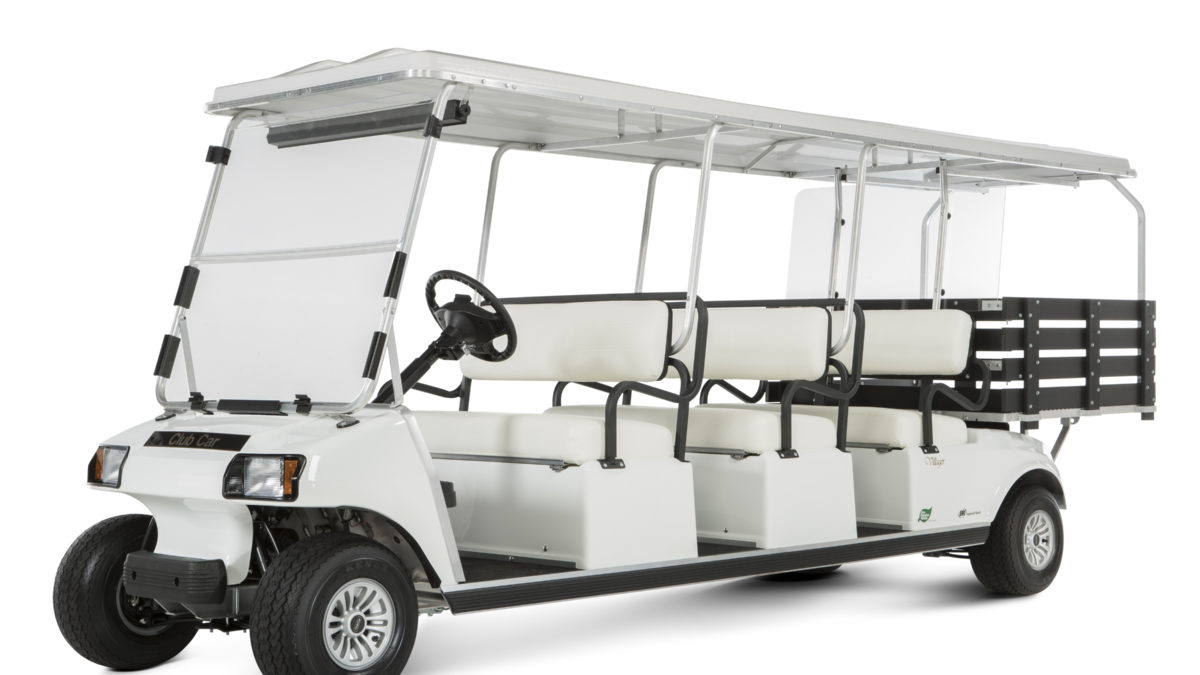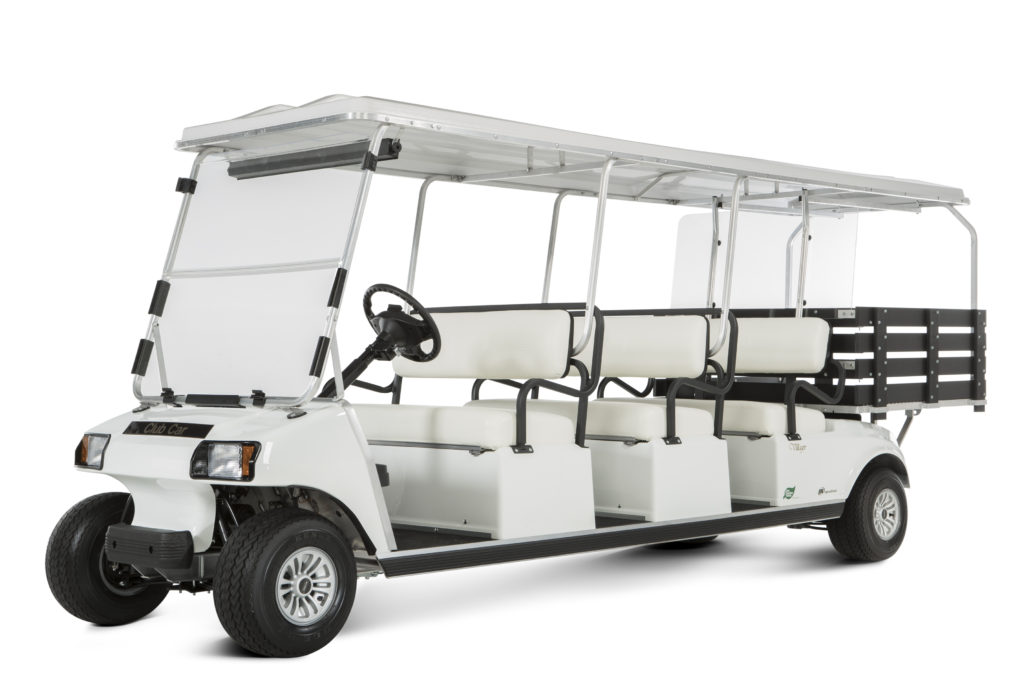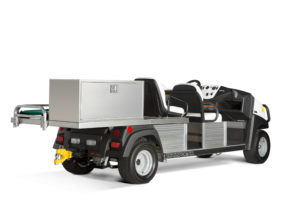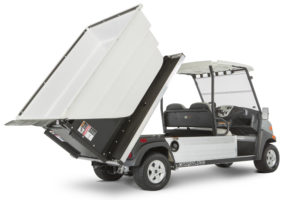

Club Car’s Villager 8 electric vehicle
Airports everywhere rely on electric utility vehicles in a variety of applications from transporting passengers through terminals to moving luggage to securing parking lots and areas around planes.
But there can be big differences in the power, performance and durability of electric UTVs. FMs need to make sure that the battery pack and controller deliver the range and power to meet their needs, that the frames will stand up to wet, corrosive environments and that the chargers are smart and on board.
The McMorrow Reports asked Bill Dakuras, global director of sales and business development at Club Car, to tell FMs how to get the most for their money when purchasing electric utility vehicles.
To begin your selection . . .
Electric work utility vehicles can cut your airport’s fuel bills and help meet regulatory standards, such as Leadership in Energy and Environmental Design (LEED). But unless you do your due diligence you may sacrifice power, performance and durability for sustainability.
Begin the selection process by taking into account your operating environment.
The water, salt and chemicals used and located around airports can cause rusting. Look for vehicles built on rustproof, corrosion-resistant aluminum frames with aluminum bed boxes. Steel frames, even when coated, tend to rust in these environments. Vehicles with aluminum frames and bed boxes will generally last longer.
Power: Battery Packs and Controllers
Make sure the vehicles will deliver the power you need. Generally, those with 48-volt battery packs and 500-amp controllers are the most powerful of the standard offerings.
Yet many vehicles have 350- or 400-amp controllers, so they don’t carry or tow as much weight as those with more powerful controllers.
Consider, for example, a mid-sized vehicle manufactured by a major brand with a 400-amp controller and a 48-volt battery pack. Its bed load capacity is 600 lbs. (272 kg), and its towing capacity is 1,000 lbs. (45.35 kg).
A comparable vehicle made by another major manufacturer features a 48-volt battery pack but a more powerful 500-amp controller. This vehicle delivers a bed load capacity of 800 lbs. (362.8 kg), 200 pounds more than the vehicle above. Its towing capacity is 1,500 lbs. (680.3 kg), 500 lbs. more than the other vehicle. As a result, it slashes travel time, boosts productivity and potentially lasts longer.
Further, the 500-amp controller features controlled downhill ability when loaded or unloaded, plus zero-speed detect to prevent roll away. Vehicles with 400-amp controllers may freewheel in descent until they reach 7-9 mph. Controlled descents improve brake shoe life and safety.

Club Car Transporter Ambulance electric vehicle
Better Hill Climbing
Some vehicles feature DC motors, others use AC motors. AC motors are noted for better acceleration and speed on hills. The higher torque of the AC motor allows better hill-climbing power when running at full speed, but it lacks low-end torque for pulling loads on hills, especially after stopping on a hill. If you stop on a hill with a full load using an AC motor, the vehicle may not have enough torque to get started up the hill again.
DC motors, on the other hand, produce all available torque at low RPM, so they can pull heavy loads even when taking off from a stop position on a hill.
Make sure your controller offers standard regenerative braking, hand-held speed programmability and diagnostic capabilities. Good diagnostics let you track the vehicle’s usage, running hours and miles covered for effective car rotation in larger fleets. They also issue automotive-style fault alerts that can help you prevent expensive damage, accidents and downtime.
Get the Range You Need
Range is another issue to consider. Speak to your sales professional about how many hours a day and in what applications the vehicles you are buying will be used. Range is something customers often over- or under-estimate, so you may want to track this before buying.
Standard deep-cycle lead acid batteries deliver 15-30 miles of range. Upgraded extended range battery packs can increase this range, and possibly the warranty.
In high-use applications it may be worthwhile to purchase optional extended range lead acid batteries that get 50+ miles per charge.
Relatively new to UTVs are lithium ion batteries. They provide a range similar to extended range lead acid batteries, but generally cost twice as much.
Lighter vehicles, built on aluminum frames, consume less battery power to do the same job, which also extends range.

Club Car Trash Pick up electric vehicle
Streamline Charging
Take a close look at the charger. You may want vehicles that allow for “opportunity charging” at various sites around your airport. This requires vehicles with on-board chargers and reel retractors that let your crews charge their cars during lunch breaks and other free time. Make sure these come standard. Some manufacturers offer these only as an option, at added costs.
To prevent common user errors and downtime, look for smart chargers that tell you when the car is plugged in and receiving power, and issue state-of-charge alerts. This can prevent dead cars and increase soft savings.
Simplify Maintenance
Even with the best electric cars, proper battery maintenance is critical for extending the life of your battery, yet this often falls between the cracks in busy airport environments.
Single-point watering systems (SPWS) may pay for themselves as they simplify battery maintenance, lower labor costs and extend the life of the vehicle. Look for a manufacturer who offers special “packages” that include common options such as SPWS, extended range batteries, canopies and more. These accessories are less expensive when bought as part of a package.
Warranty, Support and Service
A new lead acid battery pack can set you back as much as $1,500. To avoid expensive surprises and budget fluctuations, buy vehicles with the longest, strongest warranty you can find.
Don’t just check the battery warranty, check the warranty on the controller, motor and battery charger as well. Some manufacturers, including Club Car, cover the battery and these electrical components for four years, twice as long as others.
Comparing warranties is not always as straight-forward as it should be. Manufacturers may provide vague warranty information on their websites and marketing materials. That can be a danger sign. Make sure the terms of the warranty are clearly spelled out.
It’s also important to partner with a manufacturer who offers a large portfolio of task-multiplying commercial accessories such as van and tool boxes, stake side kits, long beds, dump beds and safety equipment. Many manufacturers carry mostly recreational accessories, and won’t give you the versatility you need.
Look for a supplier who has a contract with a government purchasing association, such as U.S. Communities, as Club Car does. This simplifies purchasing by eliminating the request for quotation process and gives you the best possible government pricing.
Think long term
Sophisticated buyers think long term when purchasing UTVs by considering not just the sticker price but the total cost of ownership. Vehicles made abroad are often less expensive than those made in America, but you can wait months for parts and service. That’s no bargain.
Buy vehicles that are made in the U.S. and backed by an extensive network of dealers and distributors for easy access to parts and factory-trained technicians.
Users are sometimes leery of electric vehicles because of the cost of battery replacements. But when you consider the cost of fuel, tune ups, oil and filters, belts and other maintenance on gasoline vehicles, electric vehicle are less costly to operate, especially in the first two years of usage. And they are environmentally friendly.
You can reach Bill Dakuras.
